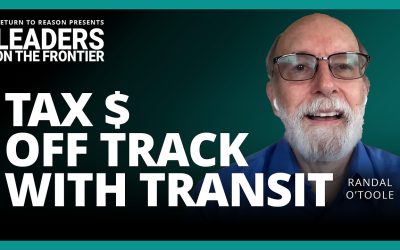In 1800, the average travel speed was three miles an hour – whether by foot or by horseback. Though a horse and rider could briefly exceed 30 miles an hour, the average speed of horse-drawn coaches was less than three miles an hour and – depending on road conditions – a 20-mile trip could take all day. At that time, U.S. per capita GDP (expressed in 2007 dollars) was $1,200.
By 1850, average travel speed increased to four miles an hour, thanks mostly to the introduction of steamboats on North American lakes and rivers, and horse-drawn streetcars in the big cities. Per capita GDP reached $1,900.
By 1900, roughly 200,000 miles of railway tracks crossed the continent and average travel speed doubled to eight miles an hour. In the final year of the 19th century, Americans travelled 16 billion passenger miles by train – an astonishing 210 travel miles for every person in the country.
After the turn of the century, electric streetcars made their appearance. New York and Chicago were running elevated rapid-transit lines. Per capita GDP multiplied to $5,000.
By 1950, average travel speed quadrupled to 24 miles an hour – and the number of miles travelled quadrupled, too. By 1913, more than one million Americans owned cars. By 1923, 10 per cent of the population did – by 1950, 30 per cent. Per capita GDP hit $12,000.
By 2000, as Oregon urban planner Randal O’Toole relates in his forthcoming book Gridlock: Why We’re Stuck in Traffic and What To Do About It, average travel speed exceeded 70 miles an hour. Cars went faster, of course, primarily because safer highways permitted higher speeds. But planes went faster still. Although airlines contributed only 10 per cent of passenger miles, they did so at more than twice the speed of ground travel. U.S. per capita GDP almost tripled to $35,000.
In his original and provocative analysis of the consequences of moving people faster, Mr. O’Toole celebrates the democratization of travel in the 20th century, deeming it the single most important factor in the insistent rise of U.S. GDP.
"The real revolution in personal mobility had to wait for the automobile and the jet airliner," he writes. "These technologies were affordable to every economic class. The wealthiest 20 per cent of Americans drive only a few more miles a year than the poorest 20 per cent. The automobile is the most egalitarian form of mechanized travel ever developed."
It is American mobility, Mr. O’Toole argues, that make the U.S. ultimately more democratic than European countries, which impose much higher taxes on cars and gasoline.
One consequence of these taxes is that Europeans are not only less mobile but poorer as well. European GDP is now stuck at a level surpassed by the U.S. in 1980. "European mobility," he says, "is more than 50 years behind the U.S."
Although his perspective is American, his arguments transfer comfortably to Canada, which experienced the mobility revolution in an almost identical way. The most significant difference, Mr. O’Toole says, is that the United States has used gasoline taxes primarily as user fees to build roads and highways; Canada has used a higher percentage to pay for other government services, most conspicuously public transit.
Mr. O’Toole (whose book will be published in January by the Cato Institute, a Washington-based think tank for which he is a senior fellow) concedes that U.S. governments have subsidized all forms of transportation but says the user-pay principle has kept subsidies to cars at a minimum. In the United States, he says, total subsidies in 2000 came to less than 0.1 cents per passenger mile for airlines and airports; 0.8 cents per passenger mile for cars and highways; 14 cents per passenger mile for trains (Amtrak); and 50 cents per passenger mile for public transit.
Goaded by the green assumption that cars are environmentally wicked, Mr. O’Toole says, governments will increase subsidies for public transit in the years ahead – as long as these subsidies can be sold as job creation programs. He argues that the green assumption is wrong. Between 1970 and 2006, Americans increased the distance they drove by 166 per cent. In the same period, emissions of all kinds fell dramatically – from carbon monoxide (67 per cent) to lead (93 per cent).
Further, he argues, the proportion of Americans who use public transit peaked in 1964, when Congress coincidentally passed its first Urban Mass Transportation Act, which entrenched federal spending on public transit. In the past 50 years, the operating cost of U.S. public transit (per trip) has risen by 230 per cent (adjusted for inflation) and average fares have fallen by 24 per cent. Further investment, he says, will lower the productivity of public transit once again.
Further still, he notes, 1964 was the first year in its history that Japan’s famous high-speed transit service lost money. The "bullet trains" have never made a profit since. From 1964 through 2005, driving in Japan increased by 900 per cent – while train use increased only 19 per cent. Small, efficient cars now carry Japanese commuters more than 2.5 times as far as high-speed trains.
Yet Mr. O’Toole regards the modern superhighway as hopelessly obsolete – and says the technology exists to take average travel speeds to 100 miles an hour and beyond.


